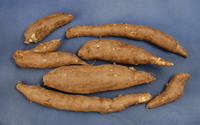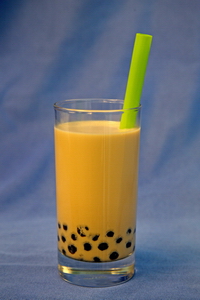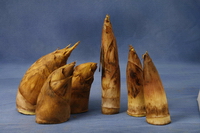
Food Safety Focus (19th Issue, February 2008) – Incident in Focus
Cyanide Poisoning and Cassava
Reported by Ms. Joey KWOK, Scientific Officer,
Risk Communication Section, Centre for Food Safety
Background
On 14 January 2008, the Centre for Food Safety (CFS) advised members of the public to avoid consuming Piranha brand crackers and snacks manufactured by Tixana Australia Pty Ltd. The appeal was made following a warning issued by the Food Standards Australia New Zealand (FSANZ) due to the higher-than-usual levels of naturally occurring cyanogenic glycosides in the ingredient cassava in a batch of exported vegetable crackers. The CFS contacted the relevant authorities and was informed that the affected products had been exported to Hong Kong. The CFS alerted the trade to stop selling the affected products.
What are Cyanogenic Glycosides?
Cyanogenic glycosides are a group of chemical compounds which occur naturally in over 2 000 plant species. There are at least 25 cyanogenic glycosides known to be found in the edible parts of plants. Cyanogenic glycosides alone are relatively non-toxic. However, as a result of enzymatic hydrolysis by beta-glucosidase following maceration of plant tissues as they are eaten, or by the gut microflora, cyanogenic glycosides are broken down to release hydrogen cyanide which is toxic to both animals and humans. The potential toxicity of a cyanogenic plant depends primarily on its capacity to produce hydrogen cyanide.
What are the Symptoms of Cyanide Poisoning?
In humans, the clinical signs of acute cyanide intoxication include rapid respiration, drop in blood pressure, rapid pulse, dizziness, headache, stomach pain, vomiting, diarrhoea, mental confusion, twitching and convulsions. Death due to cyanide poisoning can occur when the cyanide level exceeds the limit an individual is able to detoxify. The acute lethal dose of hydrogen cyanide for humans is reported to be 0.5 to 3.5 mg per kilogram of body weight. Children are particularly at risk because of their smaller body size.
Chronic cyanide intoxication may lead to the development of certain conditions including disturbance of thyroid function and neurological disorders. It tends to affect those individuals who have regular long-term consumption of cassava with poor nutrition status.
What is Cassava? What is it Used for?
The roots of cassava are rich in carbohydrates, mainly starch. According to Food and Agriculture Organization, cassava is the third most important source of calories in the tropics, after rice and corn. Cassava is consumed in a variety of ways, including eaten as whole root, grated root or root chips. In addition, it is prepared into flour which in turn can be used for cooking or production of cassava-based products such as breads, crackers, and puddings or beverages made with tapioca pearls. Cassava leaves are also eaten in some countries following extensive boiling. Apart from being used as human food, cassava products are also used as animal feed.
Illustration: Cassava

Illustration: Pearl milk tea drink with tapioca pearls

How should Cassava be Processed to Render it Safe for Consumption?
Cassava contains more than one form of cyanogenic glycosides. Different varieties of cassava are generally classified into two main types: sweet cassava and bitter cassava. Sweet cassava roots contain less than 50 mg per kilogram hydrogen cyanide on fresh weight basis, whereas that of the bitter variety may contain up to 400 mg per kilogram.
Sweet cassava roots can generally be made safe to eat by peeling and thorough cooking. However, bitter cassava roots require more extensive processing. One of the traditional ways to prepare bitter cassava roots is by first peeling and grating the roots, and then prolonged soaking of the gratings in water to allow leaching and fermentation to take place, followed by thorough cooking to release the volatile hydrogen cyanide gas. Cutting the roots into small pieces, followed by soaking and boiling in water is particularly effective in reducing the cyanide content in cassava. Whilst fresh cassava requires traditional methods to reduce its toxicity, adequately processed cassava flour and cassava-based products have very low cyanide contents and are considered safe to use.
What Other Edible Plants Contain Cyanogenic Glycosides?
Bamboo shoot is a popular food item among Asian population. The cyanogenic glycoside present in bamboo shoot is decomposed quickly in boiling water. Other edible plants containing cyanogenic glycosides include kernels within the pits of some stone fruits (e.g. bitter apricot kernels), lima beans, etc.
Illustration: Bamboo shoot

Advice to Consumers
- Buy food from reliable suppliers.
- Prepare cyanogenic plants such as cassava and bamboo shoot properly before consumption. Cyanogenic plants should be cut into smaller pieces, soaked in water and cooked thoroughly in boiling water.
- Maintain a balanced diet to avoid excessive exposure to harmful chemicals from a small range of food items.
Advice to the Trade
- Source food and ingredients from reliable sources.
- Adhere to the Good Manufacturing Practice to minimise the risk of natural toxins in food.
Further Information
Further information about natural toxins can be obtained from the following webpages:

